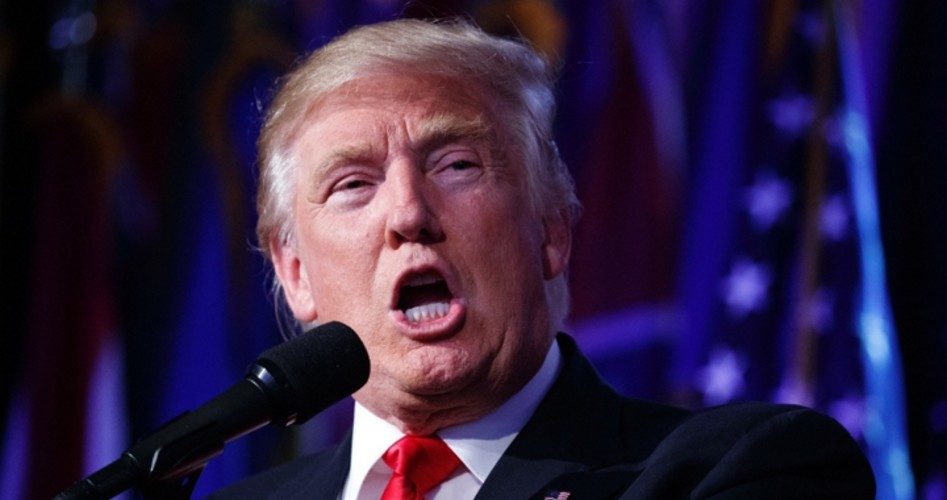
After eight years of a president who claimed we “can’t wait” for Congress to pass laws so he used his “phone and pen” to issue diktats in the form of executive orders, a new Oval Office occupant will have the authority to rescind much of those unconstitutional fiats.
On November 10, townhall.com published a list of 100 executive orders they “expect to see Trump handle immediately.”
Of the 235 executive orders issued by Barack Obama, the following are presumed to be among the first batch abolished by President-elect Donald Trump once he is sworn in:
Climate change — The Paris Agreement, EPA regulations, Clean Power Plan
Trade — North American Free Trade Agreement (NAFTA), Trans-Pacific Partnership (TPP) Negotiations
Healthcare — Any order that supports Obamacare (a program that Congress has to repeal)
Immigration — Deferred Action for Childhood Arrivals program (DACA)
National Security — Ensuring Lawful Interrogations, Iran Sanctions
Over at The National Interest, Brad Bishop added a few more Obama-era executive orders to the list of likely candidates for repeal. Those orders not included on the Townhall list are:
Executive Amnesty. The new president must repeal Obama’s unilateral changes to our nation’s immigration laws, which exempted certain categories of illegal aliens from being deported. (This bar on deportations was halted by a court order, but the underlying exemption still remains on the books.)
Life and Religious Liberty. Trump should reverse Obamacare’s unprecedented taxpayer funding of abortion. He should also direct the secretary of Health and Human Services to undertake a rulemaking process that will end the mandate for insurance to cover abortion-inducing drugs and contraception, along with “gender transition” therapies and surgeries.
“Gender Identity.” Trump should repeal the Obama administration’s Title IX guidance equating “gender identity” with “biological sex.” The Department of Justice and Department of Education have wielded this guidance to punish educational institutions for “discrimination” under Title IX, simply for having separate showers, locker rooms, and bathrooms for men and women.
There is one executive order not mentioned by any of the several pundits and journalists who have compiled lists of executive orders that should be axed by Donald Trump. This is an executive order signed by Barack Obama on March 16, 2012.
This proclamation parading as law grants to the White House absolute control over all the country’s natural resources in case of a natural disaster or during a time of war.
In the National Defense Resources Preparedness Order, President Obama granted to himself (and presumably to his successors) the authority to approve the dispensing of all domestic energy, production, transportation, food, and water supplies as he deems necessary to protect national security.
Despite the national defense hurdle that ostensibly must be jumped in order for the order to take effect, the text of the document itself does not limit implementation to a time of war. In fact, the specific sections of the order make it clear that the president may take complete command and control of the country’s natural resources in peacetime, as well.
In fact, the president may invoke the powers of this order to “meet national defense requirements” in “the full spectrum of emergencies.”
Someone with access to the president-elect should suggest rescinding this executive order on his list of priorities for his first 100 days.
The authors of the above-referenced lists believe that, as president, Donald Trump could use executive orders to undo much of the damage that has been done during Barack Obama’s tenure in the White House.
That is certainly true, particularly in regard to the topics the proposed cull list covers. President Obama’s penchant for legislating from the Oval Office is notorious and noteworthy and should serve as a cautionary tale for anyone — Donald Trump included — who would use the presidential pen to demolish the constitutionally constructed walls separating the powers of the three branches of the federal government.
Given his audacious addiction to ruling by executive order, readers might be surprised to learn that in 2008 one of candidate Obama’s criticisms leveled at George W. Bush was his use of signing statements and executive orders to effect legislation.
Once in office, however, President Obama’s personal experience with congressional resistance to his agenda gave him second thoughts about the utility of these controversial codas.
As was reported by The New American, President Obama often sidestepped congressional impediments to achieve his legislative goals by using executive orders and signing statements.
A presidential signing statement is a pronouncement that the president appends to a bill he signs into law. Nowadays, this executive addendum sets forth the president’s understanding of the law and gives guidance to the myriad departments under the executive branch umbrella on how to carry out the requirements of the new legislation.
Signing statements change the laws, revoking parts of them or adding provisions to them, at the same time redefining the Constitution and nullifying its checks and balances. Using them, the president assumes all power — executive, legislative, and judicial — unto himself and does so in a manner that is beyond question, beyond debate, beyond vote, and thus beyond the reach of the American people.
With his historical pace of issuing signing statements and executive orders, Barack Obama is able to sit quietly and victoriously in the solitude of the Oval Office, having his monarchical cake and eating it, too.
The specter that should frighten Americans now, however, is that this usurpation of legislative authority has established the presidency as an avowed and open enemy of republican government and a position that for generations has determined to amass governmental power into each president’s hands and into the hands of his successors.
During the debates of the constitutional convention of 1787, Virginia delegate Edmund Randolph (he was also then the governor of the Old Dominion) foresaw this possibility and warned that the immense powers given to the president in the Constitution was the “fetus of monarchy.”
The several states, Randolph said, “had no motive to be governed by the British government as [their] prototype.”
About a week later, Alexander Hamilton of New York rose and presented a detailed plan of government that would require the states to surrender a vast swath of sovereignty to the federal government, a plan that included an immensely powerful president.
Believe it or not, Hamilton promoted the creation in the Constitution of a president for life! Such a scheme, Hamilton argued, would be guard “against the tumults excited by the intrigue and ambition of competitors.”
Furthermore, a president of indefinite term would be a “safer depository of power.”
Thankfully, Hamilton’s plan was rejected by the delegates in Philadelphia and a much weaker executive was created, an executive without legislative power (aside from the exercise of the veto of bills passed by Congress) and one that could not act as an elected monarch.
The nearly 63 million Americans that voted for Donald Trump would be disappointed if their preferred president continued his predecessors’ practice of ruling by executive order.
For today, there is every hope that as president, Donald Trump will take the constitutionally permitted steps necessary to undo all of President Obama’s efforts to create an executive possessed of usurped powers required to “legally” (albeit unconstitutionally) step outside the boundaries of his constitutional authority.
Beginning on January 20 — Inauguration Day — the tale will be told.
Photo: AP Images



